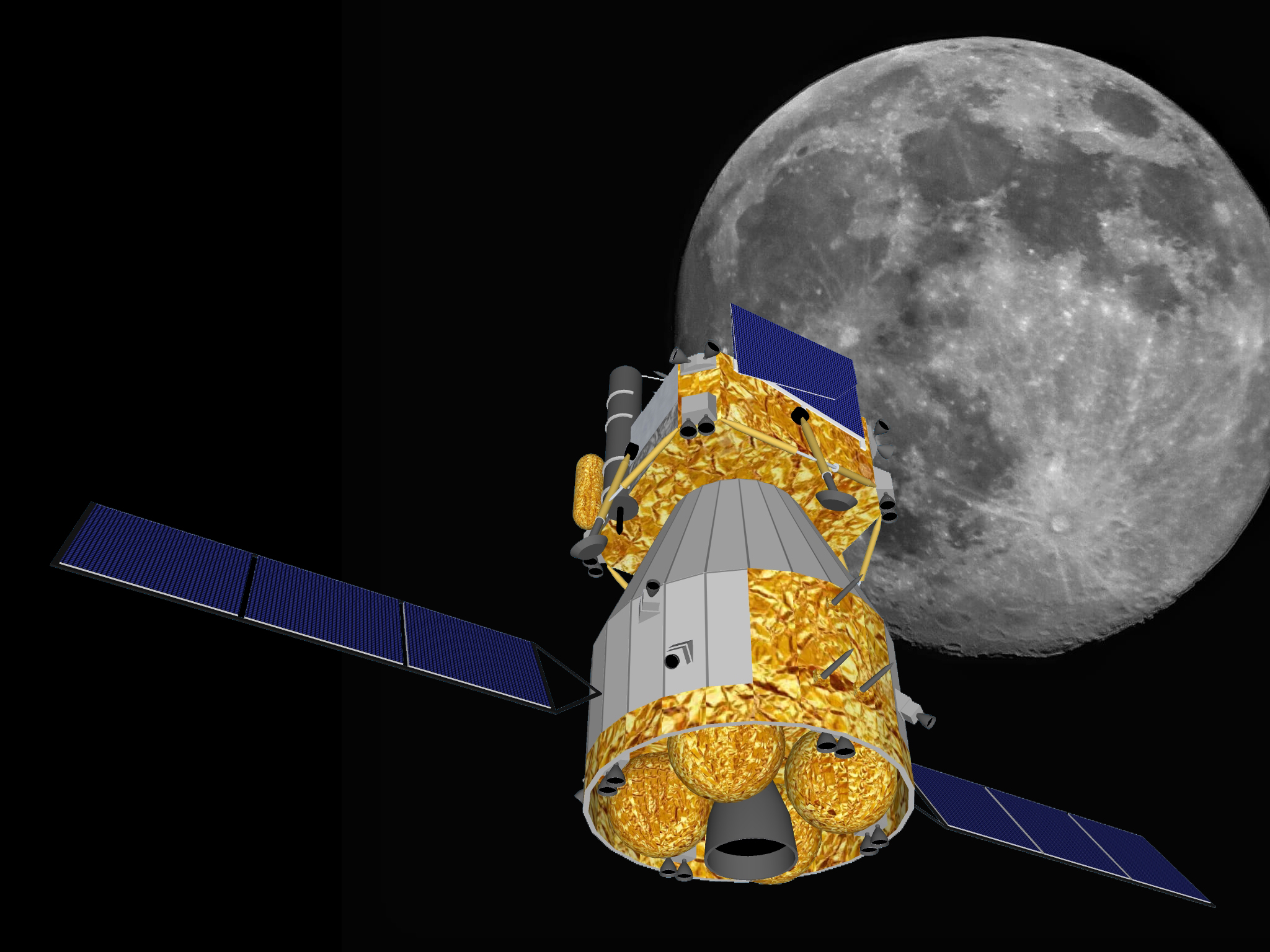Rocks from Moon – Chinese Chang’e 5 is flying back to Earth
44 years after Luna 24 another space mission tries to bring moon samples from our cosmic neighbor back to Earth. Read about China’s Chang’e 5 mission.
China already send their Mars flagship Tianwen with a Orbiter, Lander and rover this summer to mars. The landing is planned for early 2021. But they want to achieve another big step in space in this year: 44 years after soviet spacecraft Luna 24 brought samples from our neighbor Moon back to Earth the young spaceflight nation China wants to do this on 1st December 14:58 UTC, too. The USA who went six times with humans to the moon surface didn’t tried a robotic sample return mission yet. So Info Shymkent want to have a deeper look on this ambitious space mission.
The flight plan of Chang’e 5
Passed events of Chang’e 5
23th November (Launch and flight to Moon):
- The launch occurred 20:30 UTC on November 23 (02:30 Almaty time on November 24).
- China’s tallest (57m height) and strongest (9,600 kN) rocket Long March 5 (LM-5) / Chang Zheng 5 (CZ-5) brought Chang’e-5 into earth orbit.
- The second stage of LM-5 initiated the Trans-Lunar-Injection (TLI) to send the spacecraft to the moon. The flight time will be around 112 hours / 4.6 days to the moon.
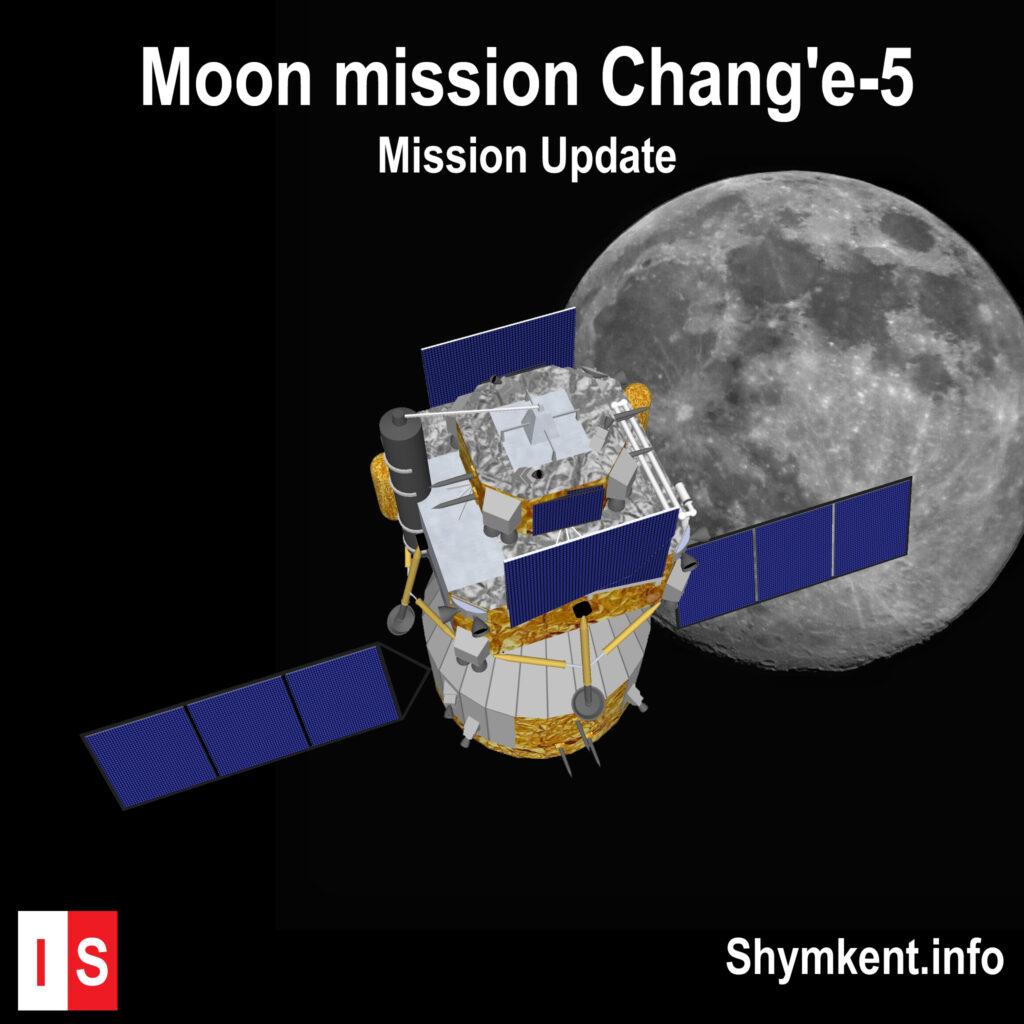
24th November (1st flight correction maneuver):
- The 1st trajectory correction maneuver was performed by 3000 Newton strong main engine and happend at 14:06 UTC and lasted for 2 seconds.
- All systems are in good health.
- Chang’e-5 is already 160,000 km away from Earth.
25th November (2nd flight correction maneuver):
- The 2nd trajectory correction maneuver was performed by two 150 Newton engines and happend at 14:06 UTC and lasted for another 2 seconds.
- Chang’e-5 is now 270,000 km away from Earth.
27th November (Sunset over landing site):
- The Sunrise over the planned landing site Mons Rümker was ongoing.
28th November (Chang’e 5 arrival at Moon):
- Close to the Moon – at 28th November 12:58 UTC – was the Lunar Orbit Injection (LOI) that brought Chang’e-5 in a 217 x 5585 km elliptical orbit around the moon.The main work was performed by main engine of the orbiter.
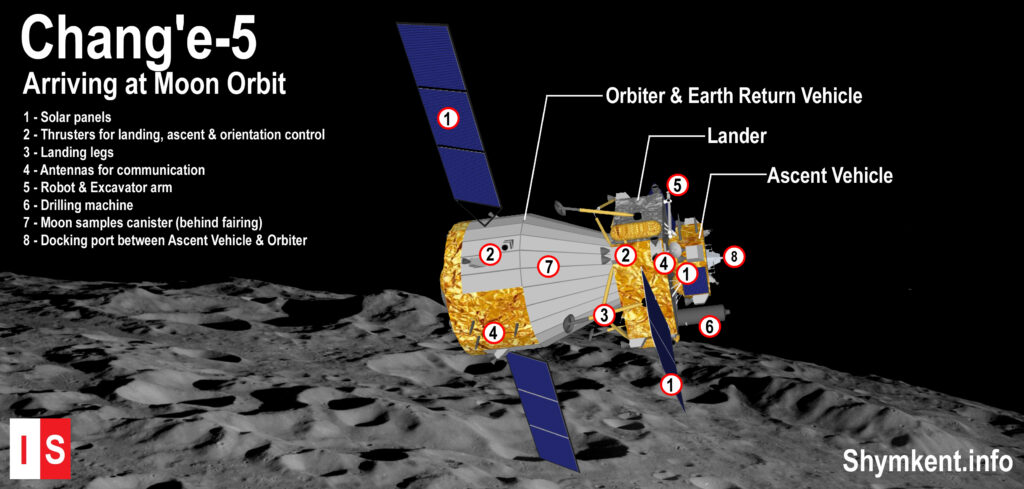
29th November (Chang’e 5 improve it’s lunar orbit):
- A orbit correction maneuver occurred at 29th November 12:39 UTC to bring the spacecraft in a circular orbit of around 217 km above the moon.
30th November (Start of Chang’e 5 landing attempt):
- The orbit was perfect for the landing of Chang’e-5 – that means a orbit with 217 km above moon surface and a inclination of 45.7° – to make a landing at Mons Rümker possible. At 29th November 20:40 UTC Chang’e-5 Orbiter and Lander separated in moon orbit.
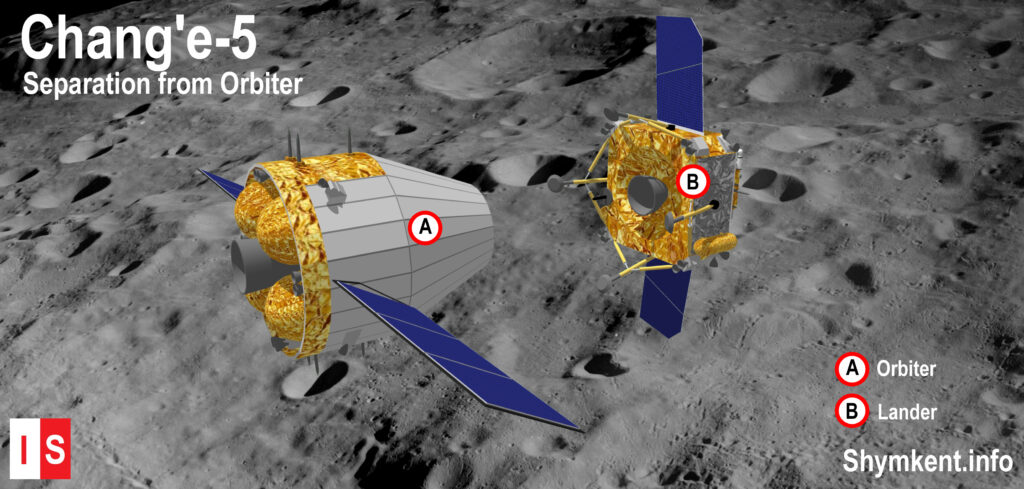
- The lander will start to lower its orbit on 30th November 14:23 UTC with a short burn and another one later this evening at 18:22 UTC. The orbiter and earth return vehicle remains in orbit.
1st December (Landing attempt):
- Finally descent to the lunar surface occured on 1st December 14:58 UTC. This process is autonomous. The lander searched for its best place to land by its own. Landing was 15 min later – on 1st December 15:13 UTC at Mons Rümker.
2nd till 3th December (Ground operations):
- The Lander took samples by drill machine and the excavator arm. Three parts of the samples are from Excavator arm, one part is soil from a drill machine.
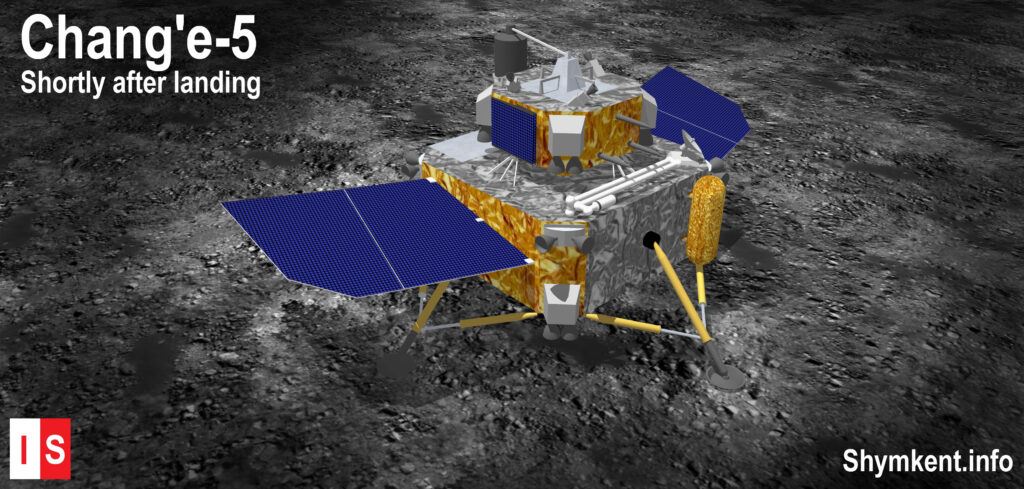
- The lander was stay for two earth days on the lunar surface and made a high resolution panorama picture of the lunar surface. The probes was transfered into the ascent vehicle already after one day.
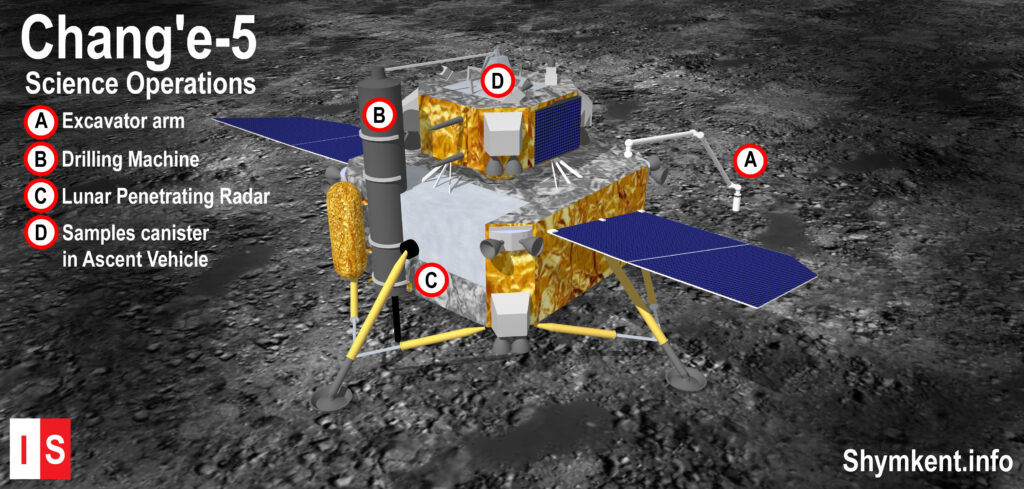
2nd & 3rd December (Docking preparation and Ascent from the moon):
- Before launch of ascent vehicle the orbiter jettisoned its adapter to enable the docking system for autonomous rendezvous and docking at 2nd December 2020 19:46 UTC.
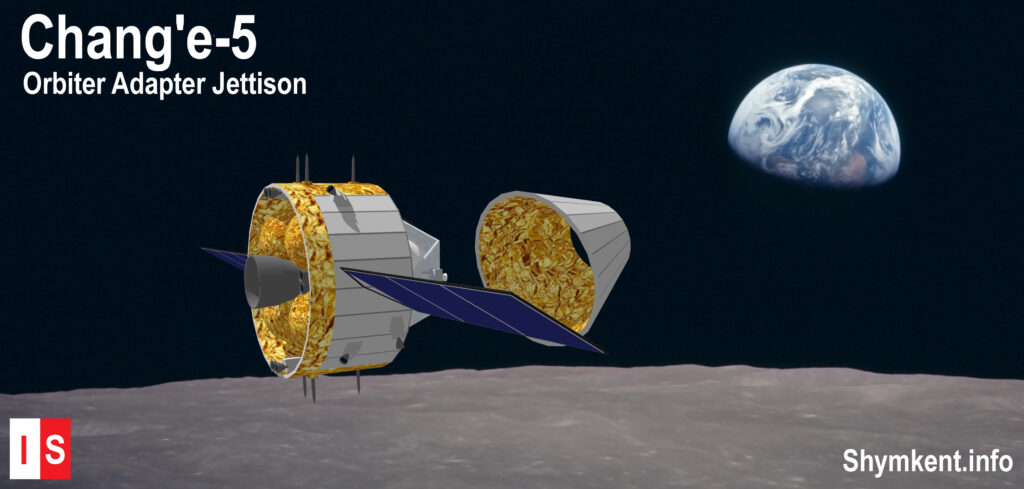
- The ascent vehicle of Chang’e 5 launched from lunar surface at 3rd December 15:10 UTC and went after launch into a 15 × 180km orbit around the moon.
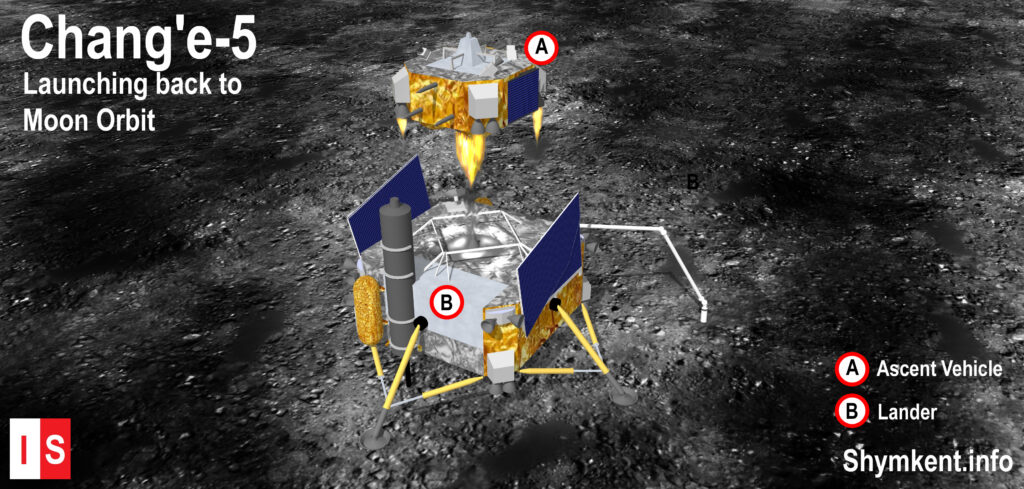
3rd-5th December (Ascend vehicle remote guidance maneuvers):
- Two days were planned for the rendezvous between the orbiter and the ascent vehicle.
- There were four rendezvous guidance maneuvers at 3rd December 22:05, 4th December 08:04 & 19:46 and 5th December 11:54 UTC.
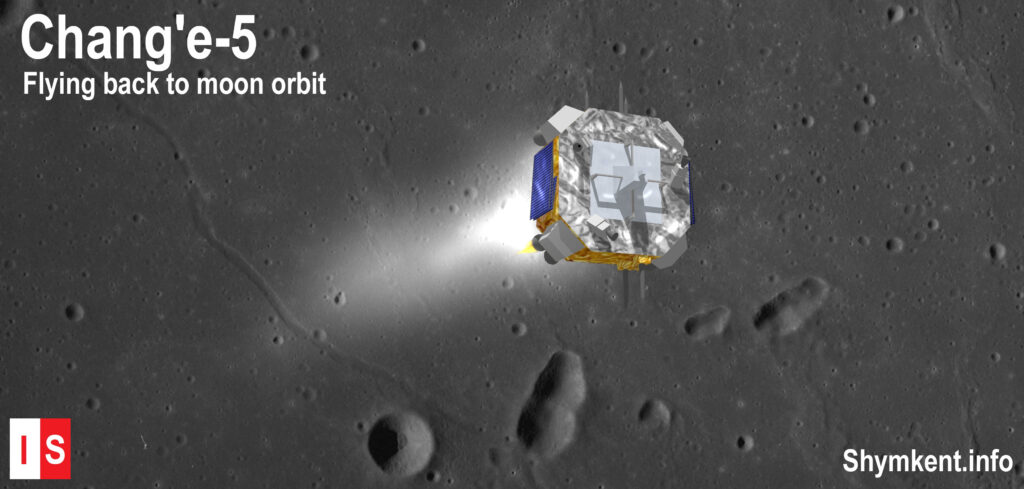
5th December (Autonomous docking in moon orbit):
- The final approach between Orbiter and Ascent Vehicle started at 5th December 18:13 UTC. Docking between Ascent Vehicle and Orbiter was achieved 3h 27m later at 5th December 21:42 UTC. It was the first time of a autonomous docking in moon orbit.
- Just some minutes later the moon sample canister was transferred from the Ascent Vehicle to the Orbiter at 22:12 UTC.
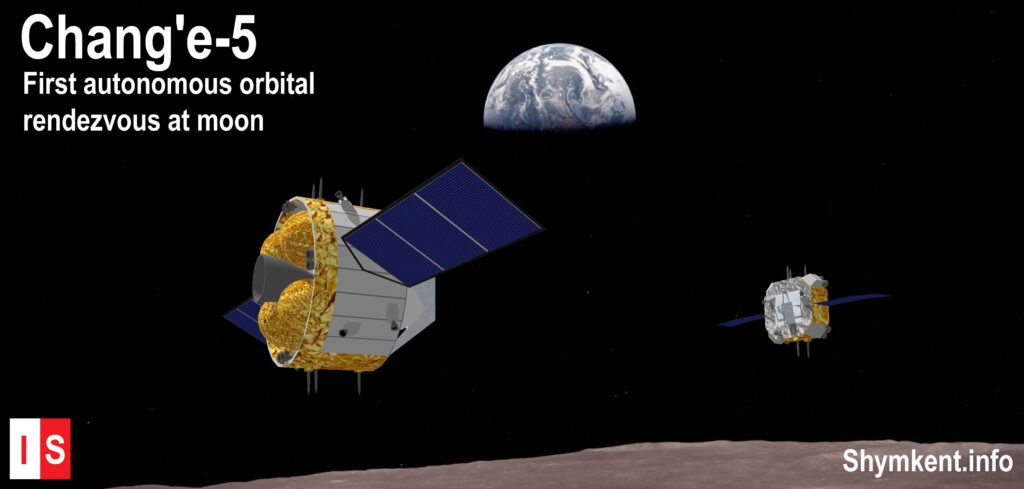
6th-12th December (Waiting for Return):
- Preparing for flight back to earth the docking adapter and the docked ascent vehicle was jettison at 6th December 04:35 UTC from the orbiter to reduce weight.
- The ascent vehicle carried out deorbiting on 8th December at 22:59 UTC and landed on the preset landing area on the moon’s surface 31 minutes later.
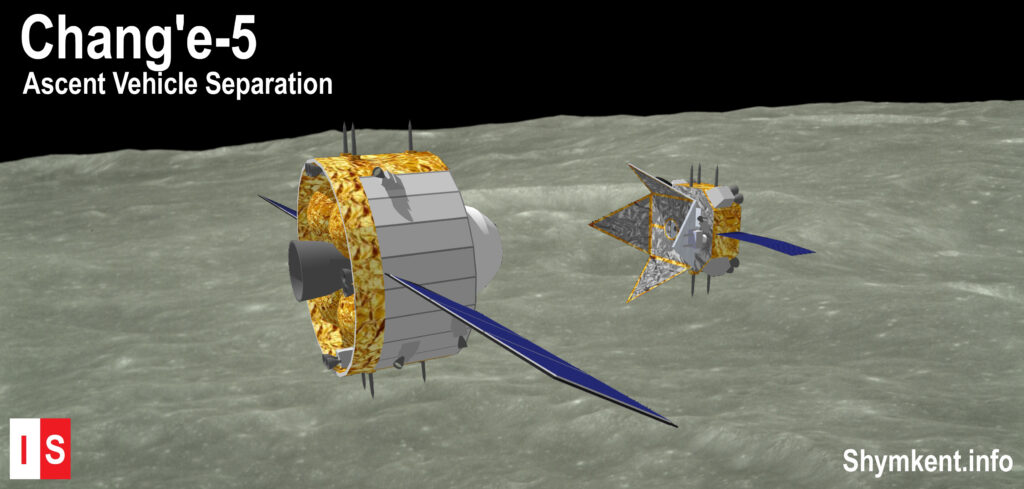
- To get the correct flight path back to earth, the orbiter with the samples on-board is waiting six days in moon orbit.
12th/13th December (Return to Earth):
- After 5 days (earlier than expected) in the lunar orbit the orbiter is initiated the first Trans-Earth Injection (TEI) at 12th December 01:54 UTC with it’s main engine.
- Second Trans-Earth Injection (TEI) was 01:51 UTC at 13th December and was performed for 22 minutes with four of its 150 Newton thrusters. This will bring the spacecraft finally on track back to earth.
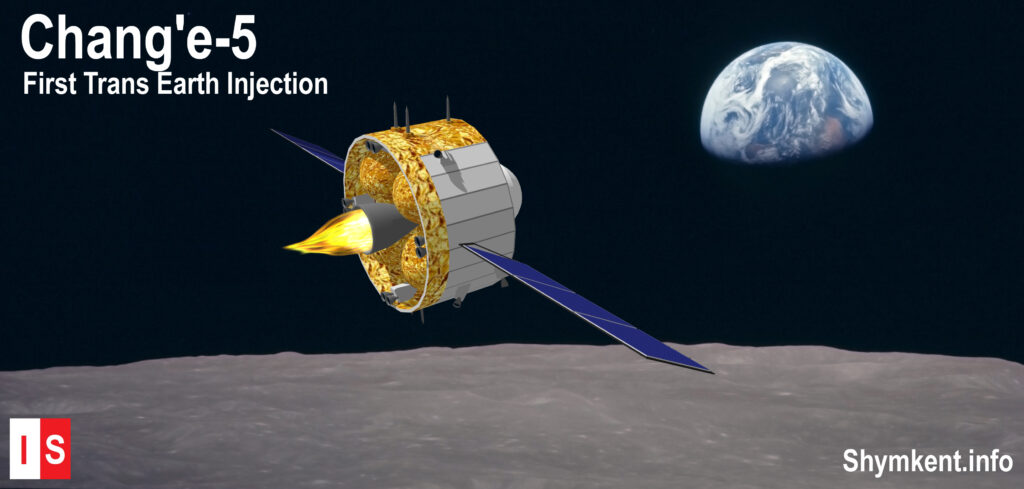
- The flight needs 112 hours for the flight back to Earth, again.
- There are three Trajectory Corrections maneuvers (TCM) required to entry correct into atmosphere and land on the correct place on earth.
- First TCM was at 14th December 3:13 UTC.
- Second TCM was at 16th December 1:15 UTC and was performed by two 25 Newton engines for 8 seconds.
- The last and third TCM was at 16th December around 12:30 UTC.
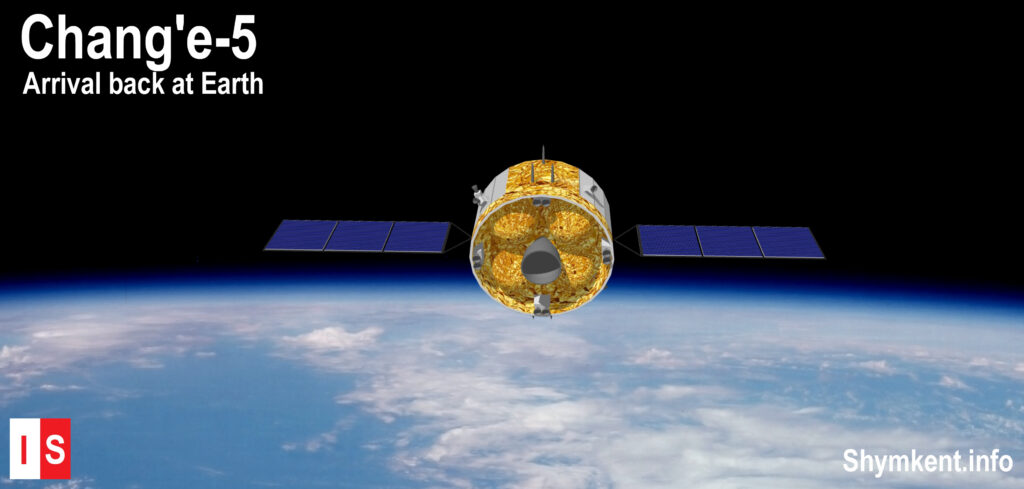
16th December (Landing on Earth):
- Reentry capsule separated from the orbiter 5000 km away from Earth around 50 minutes before touchdown in the steppe of Inner Mongolia, China.
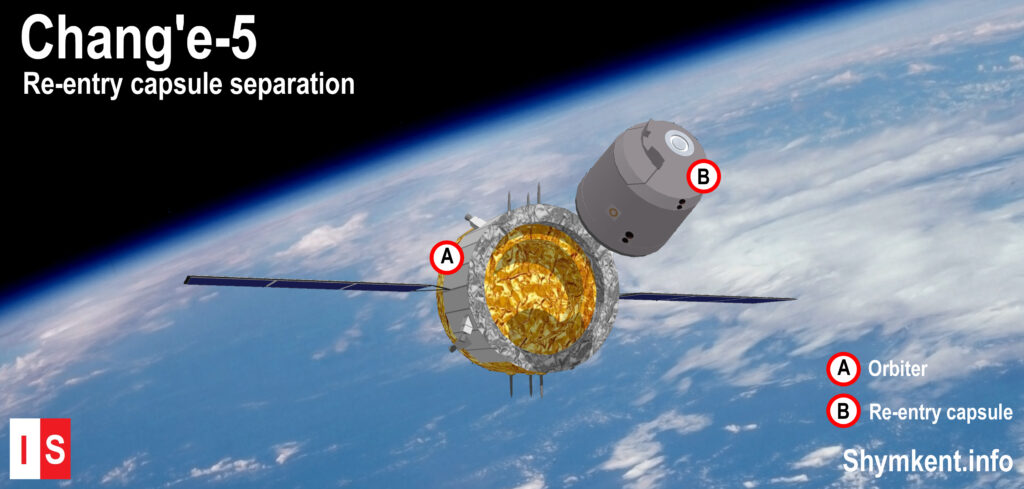
- Entry into atmosphere was like bouncing of a stone above flat water. There was two bounces in the atmosphere: It’s first entry into atmosphere was at a height 130 km above earth (20 min after separation from Orbiter) and went down to 60 km. Then it was bounced up 100 – 140 km above ground and finally went back to earth.
- Parachute was open at around 10 km above ground and 10 minutes before touchdown in the steppe.
- Entry and landing in Siziwang Banner, Inner Mongolia under parachute was at 16th December 18:10 UTC.
- Capsule was found at 18:23 UTC.
- The sealed samples were delivered to a laboratory in Beijing for further analysis at 17th December 2020. The laboratory told that 1,731 grams moon soil was in the sample canister.
- The Mission of the Chang’e-5 orbiter is not finished, yet. On 21st December 2020 China told that the orbiter will fly to a Lagrange point in the Sun-Earth system.
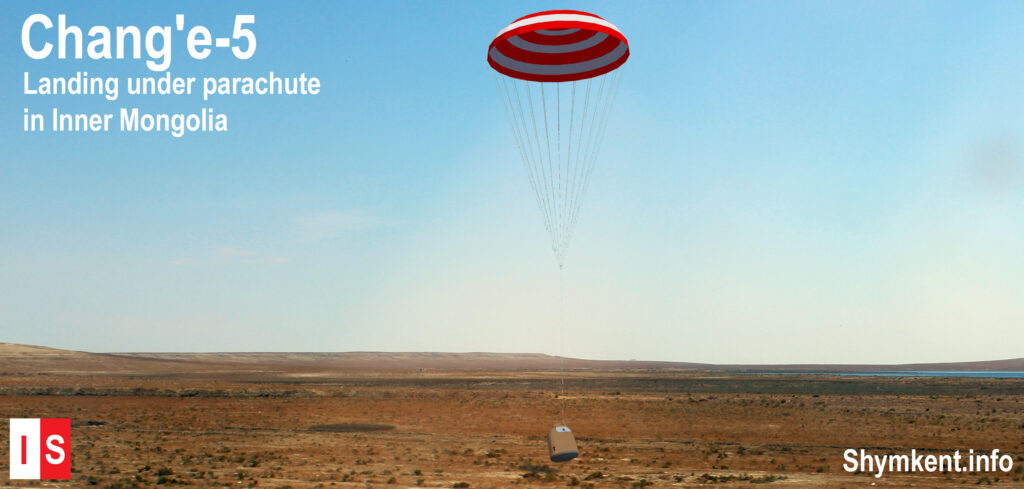
What happened if Chang’e-5 was not successful?
China build already a backup of Chang’e-5 if something goes wrong. The Chang’e-6 (CE-6) probe was produced at the same time. After the success of Change’e-5 – the CE-6 can be part of a mission to land at the lunar south pole and return probes from this interesting place.
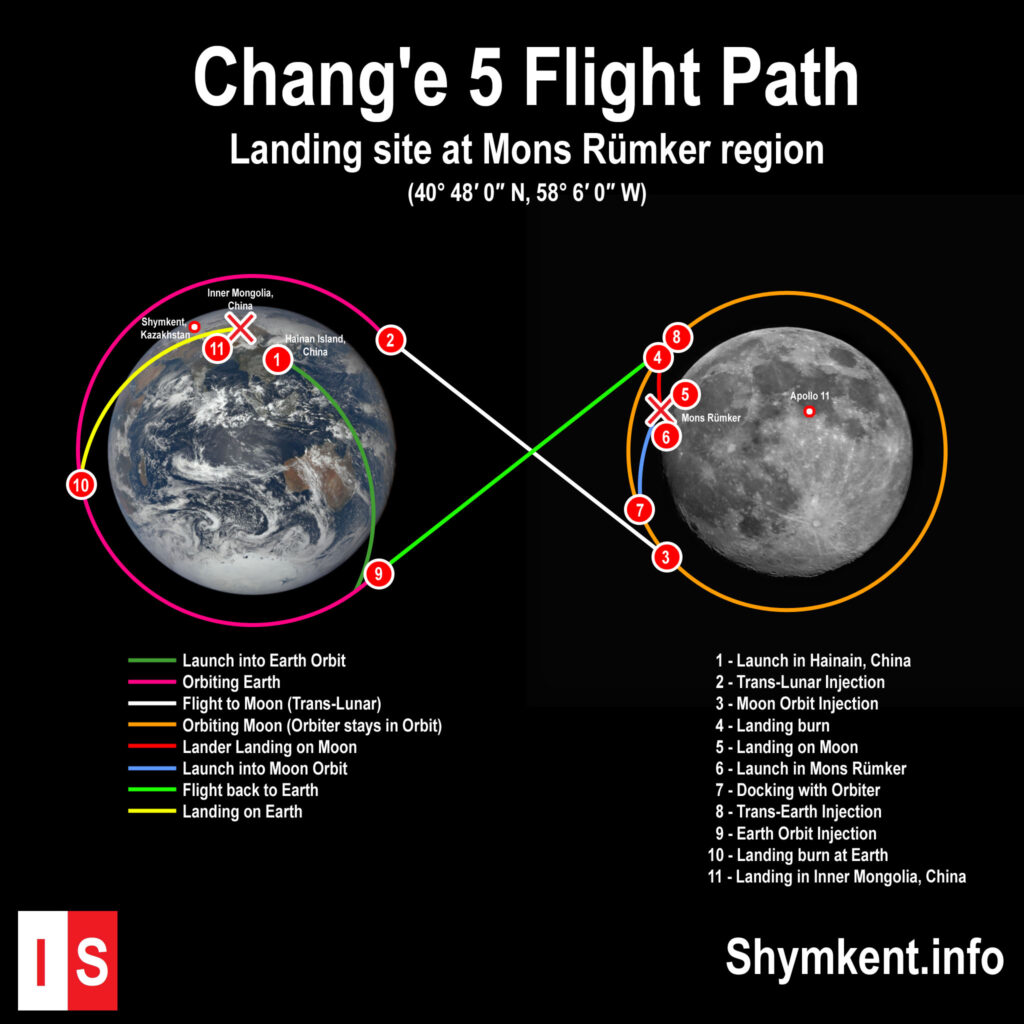
Facts about Chang’e-5
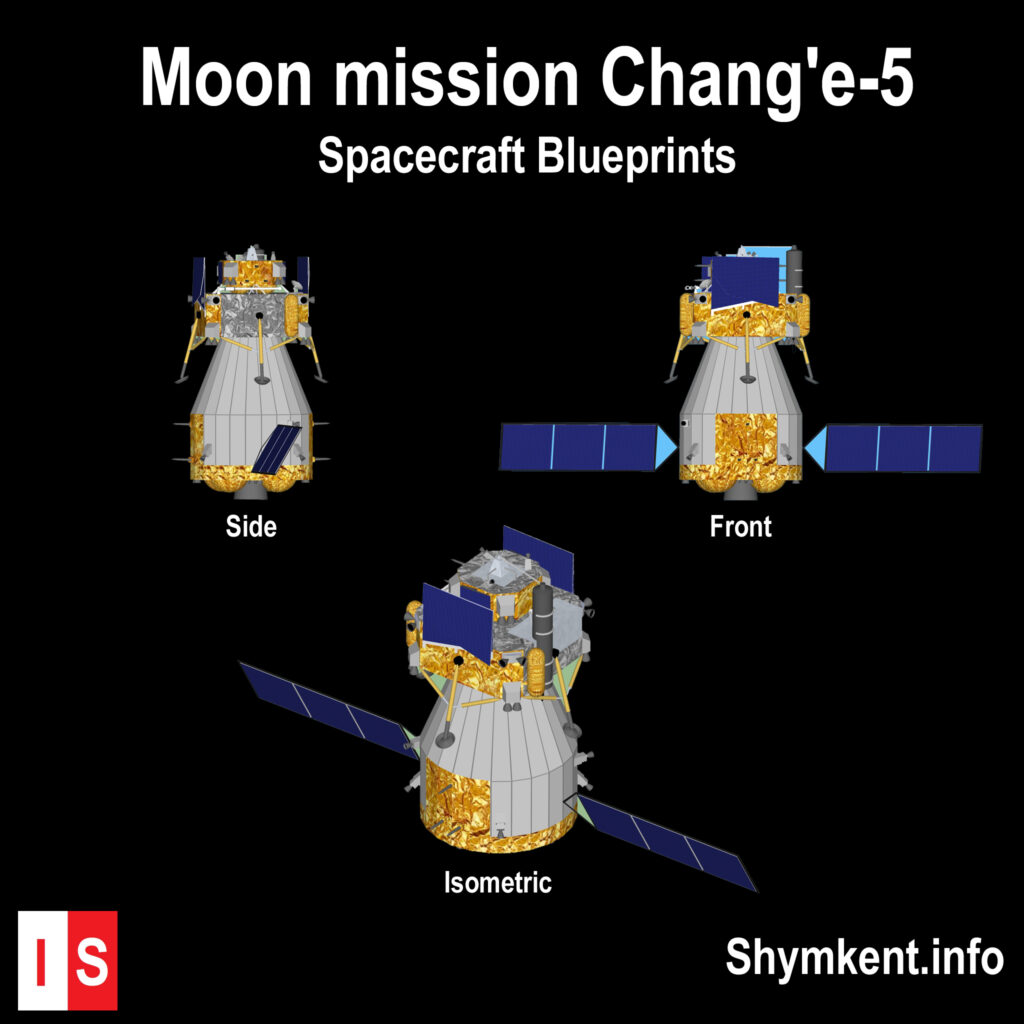
- Meaning of the Name: Chang’e-5 / 嫦娥五号 (Meaning: Name of the Chinese goddess of the Moon)
- Total weight: 8.2 tonnes (5.45 tonnes fuel)
- Propulsion / positioning control: 6 types of engines 7500, 3000, 150, 120, 25 and 10 Newton (Overall: 77 engines)
- Planned moon sample mass: 2 kg (One-third: Core probes from Drilling machine; two-thirds: moon soil taken by excavator arm)
- Launch vehicle: Long March 5 / Chang Zheng 5 (CZ-5)
- Planned mission duration: 23 days
- Science equipment on lander:
- Landing camera (for autonomous landing)
- Panoramic Camera (PCAM)
- Lunar Mineralogical Spectrometer (LMS)
- Lunar soil gas analyzer
- Lunar Regolith Penetrating Radar (LRPR)
- Thermometer
- Drilling machine and excavator arm
Why did China choose Mons Rümker as landing site?
Mons Rümker is located in Oceanus Procellarum (Ocean of Storms) – but its a very calm area. The area around Mons Rümker is very very flat and with less craters. This is one criteria to choose this place. Another one is that Mons Rümker was a Volcano and the ground in this area is volcanic origin. Chinese expect to find here very young basalt of the moon. The age could be 1.21 billion years old. The samples from the manned Apollo mission were between 3.1 and 4.4 billion years old.
How to find the landing site
During the 28th/29th November it’s was worth to watch the moon at the night sky. The moon was close to become a full moon. In the terminator (the place between night and daylight on the moon – or the ongoing sunset) you could found the Chang’e-5 landing site. The photo was a good assistant to you:
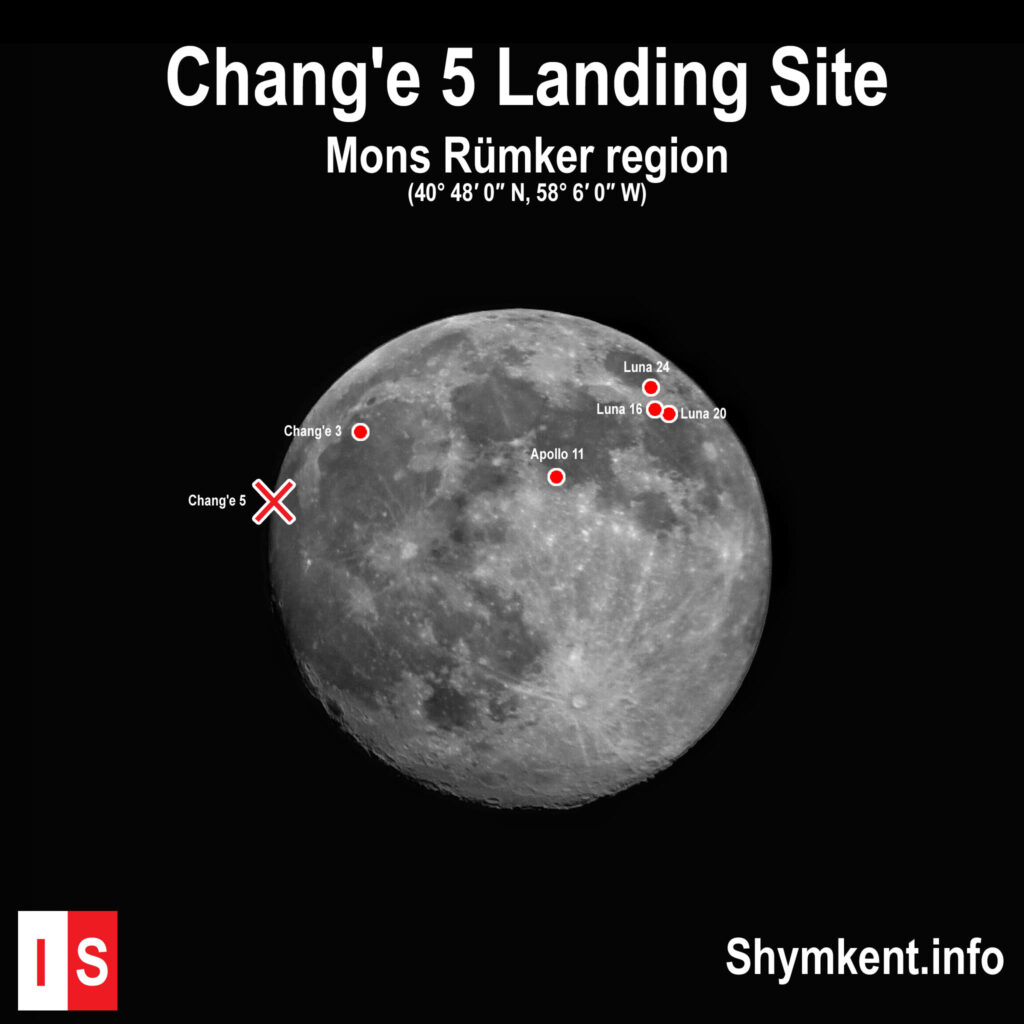
We wish China a great and successful mission to the moon and back. We will inform our readers about further information on our social media channels. Stay tuned!
Read more about Space on Info Shymkent:
- Interview with One-Year-Mission Cosmonaut Kornienko
- International Space Race to Mars
- ISS: 20 years human presence in Space
- Interview with Jonk about Forgotten Burans in Baikonur
Read more about China’s moon sample return mission Chang’e 5:



